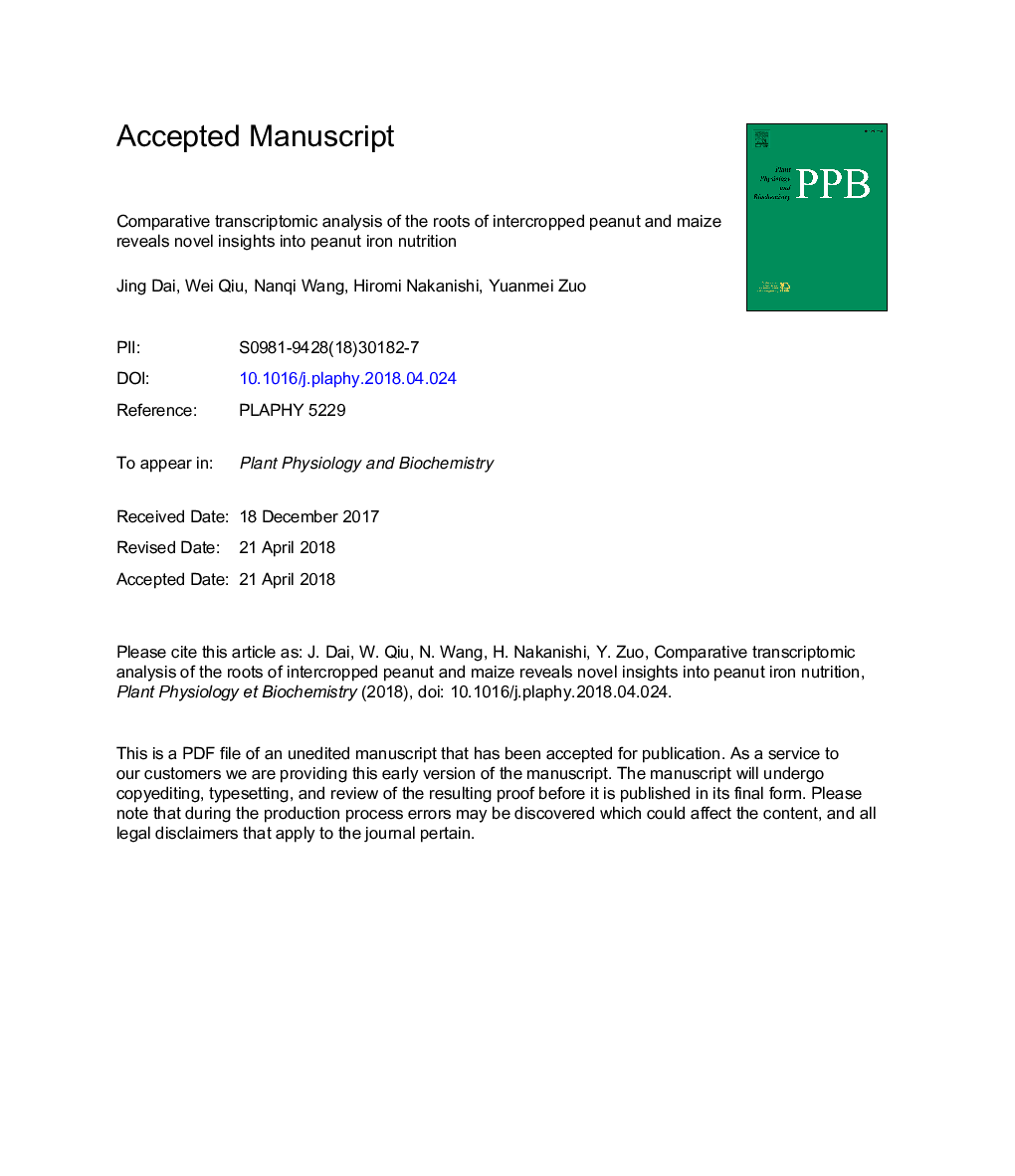| کد مقاله | کد نشریه | سال انتشار | مقاله انگلیسی | نسخه تمام متن |
|---|---|---|---|---|
| 8353200 | 1541894 | 2018 | 41 صفحه PDF | دانلود رایگان |
عنوان انگلیسی مقاله ISI
Comparative transcriptomic analysis of the roots of intercropped peanut and maize reveals novel insights into peanut iron nutrition
ترجمه فارسی عنوان
تجزیه و تحلیل تطبیقی نسبی ریشه های بادام زمینی و ذرت بین مخلوط نشان می دهد بینش جدید در مورد تغذیه آهن بادام زمینی
دانلود مقاله + سفارش ترجمه
دانلود مقاله ISI انگلیسی
رایگان برای ایرانیان
کلمات کلیدی
ACCERFSABAMTPDMTSSHABCIAAGSHIron - آهنindole-3-acetic acid - اسید Indole-3-استیکabscisic acid - اسید آبسزیکjasmonic acid - اسید جاسونیکJAs - بلهMAS - بیشترTom1 - تام 1Transcriptional analysis - تجزیه و تحلیل ترانزیتیIron nutrition - تغذیه آهنjasmonates - جاسموناتATP-binding cassette transporter - حمل کننده کاسه اتصال ATPPhosphorus - فسفرZinc - فلز رویCopper - مسGene ontology - هستیشناسی ژنیSuppression subtractive hybridization - هیبریداسیون تفکیک پذیری سرکوبPotassium - پتاسیمMetal tolerance protein - پروتئین تحمل فلزnatural resistance-associated macrophage protein - پروتئین ماکروفاژ مرتبط با مقاومت طبیعیNramp - چرت زدنCadmium - کادمیمIntercropping - کشت مخلوطGlutathione - گلوتاتیون
موضوعات مرتبط
علوم زیستی و بیوفناوری
علوم کشاورزی و بیولوژیک
دانش گیاه شناسی
چکیده انگلیسی
Intercropping is a vital technology in resource-limited agricultural systems with low inputs. Peanut/maize intercropping enhances iron (Fe) nutrition in calcareous soil. In this study, the transcriptome of peanut and maize roots was analyzed by suppression subtractive hybridization (SSH) and microarray analysis separately. We constructed four SSH libraries using the cDNA of peanut roots based on two cropping patterns: monocropping and intercropping, and two growth stages: vegetative stage and reproductive stage. Lib M1, I1, M2 and I2 comprised 53, 51, 37 and 54 genes, respectively. Six and four transporters were found in the two intercropping-specific SSH libraries, which may facilitate Fe acquisition and protoplasmic homeostasis of metal ions and anions. Specifically, AhNARMP1 and MTP may play a role in boosting Fe nutrition during the vegetative stage. The expression of MYC2 was also upregulated by intercropping, while an ethylene-responsive transcription factor was downregulated during two growth periods. Microarrays indicated that homocysteine S-methyltransferase and serine acetyltransferase 1 upregulated in intercropped maize roots, which directly associated with methionine biosynthesis. It may account for the enhanced phytosiderophore released capacity in intercropping, which benefited the Fe nutrition of intercropped peanut in reproductive stage. Two aminocyclopropane-1-carboxylic acid synthase oxidase genes, which are related to ethylene biosynthesis, were downregulated in maize root by intercropping. Taken together with our previous proteomic work, the results indicated that intercropping enhances jasmonate signaling and weakens ethylene signaling in peanut and maize roots, which may improve ecological adaptation of the peanut plant to intercropping systems.
ناشر
Database: Elsevier - ScienceDirect (ساینس دایرکت)
Journal: Plant Physiology and Biochemistry - Volume 127, June 2018, Pages 516-524
Journal: Plant Physiology and Biochemistry - Volume 127, June 2018, Pages 516-524
نویسندگان
Jing Dai, Wei Qiu, Nanqi Wang, Hiromi Nakanishi, Yuanmei Zuo,
